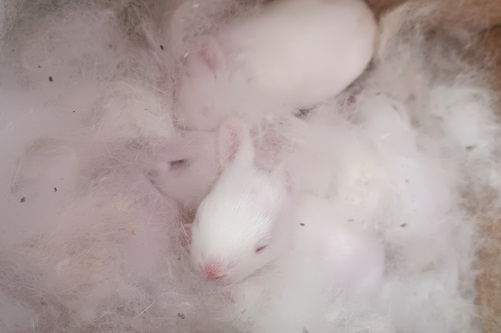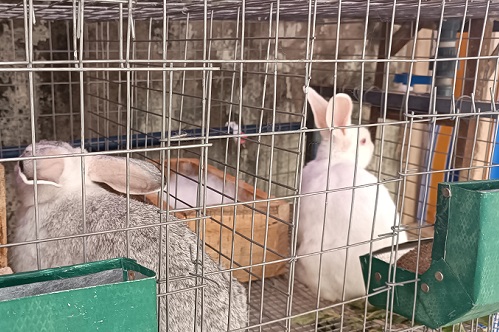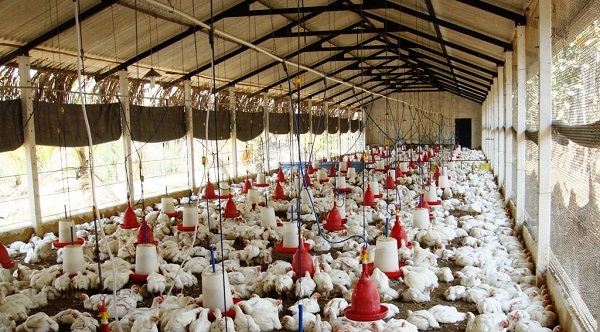There has been a significant increase in rabbit farmers in the last 3 years. This is obviously due to the profitability, ease of raising rabbits and other benefits. Rabbit farming is a great recommendation for people with little funds but interested in producing livestock. In other words, the cost of rabbit production is relatively low. The feeding, housing and other management costs are low.
Rabbit farming is also a profitable and sustainable venture. If well-managed, you will always make profits from selling rabbits or their meat. Furthermore, rabbits have a quick reproduction rate as their gestation period is 30-35 days and they can produce up to 10 kits per kindling. Another beautiful thing about them is that they can get pregnant again 2 weeks after giving birth. This means you can increase your rabbits within a short period even with just 2 does (female rabbits) and 1 buck (male rabbit).
Moreover, the demand for the meat of rabbits is increasing because their meat is white. Many health-conscious consumers now prefer to eat rabbit meat instead of beef, pork, mutton or chevon. This means there is a market for rabbits other than just selling for pet purposes.
It is worth mentioning that you do not need a huge space to raise rabbits. Rabbit hutches or cages don’t take up much space (depending on the design). Irrespective of the cage design, you can do it right in your backyard.
The Right Rabbit Breeds to Choose
Choosing the right rabbit breed is the first step to successful rabbit farming. Depending on your production goal or objective, you can choose from various rabbit breeds. If you’re interested in producing meat rabbits, some of the breeds you can select if available in your area or country are:
- French, Satin and Giant Angoras
- Champagne D’Argent
- Californian
- American Chinchilla
- Cinnamon
- Crème D’Argent
- Harlequin
- French Lop
- New Zealand
- Palomino
- Flemish Giant
- Rex
- Satin
- American Sable
- Hyla
For pets, you can choose the following:
- Checkered Giant
- Rhinelander
- English Spot
- Dwarf Hotot
- Netherland Dwarf
- Britannia Petite
Where to Buy Breeding Stock
Your breeding or foundation rabbit stock can be purchased from reputable breeders. You can get the rabbits from agricultural research institutes, recommended breeders or from us (if you are in Nigeria).
If you choose to buy from us, we will get you healthy and high-quality rabbits. We have weaners, growers and matured rabbits ready for mating. Just click here to get our contact details.
Setting Up the Rabbit Farm
Before you purchase your foundation rabbit stock, the first thing to consider is location and housing type. As mentioned earlier, rabbitry requires no big space. However, when selecting a location for your rabbitry, it’s important to consider factors such as climate as rabbits are sensitive to extreme temperatures which are detrimental to their performance and survival. Hence, you must ensure that the proposed area or location is well-ventilated, dry and even safe from predators. Even if you are choosing a backyard, ensure it is protected, free flow of air and dry.
Accessibility is another key consideration. The rabbitry should be easy for you to reach for daily maintenance and in case of emergencies. Lastly, the location should allow for future expansion. Rabbits are prolific animals and there will be the need for more space as they continue to produce over time.
After deciding on the location, the next thing is constructing the house. It is not compulsory to build a standard house for rabbits. However, if you do not have the resources for a house, ensure the cage or hutch is covered to protect the animals from direct sunlight and draft. Rabbit cages can be wooden or metal, but iron cages are always recommended. Getting cages for rabbits is easy these days. While constructing the cages yourself may save some costs, you must ensure that the construction materials are of high quality and durable. The size and building specifications for an ideal rabbit cage are as follows:
- Each cell of the cage should conveniently accommodate a full-size adult rabbit with enough room to move around. A typical rabbit cage must be at least 2ft X 2ft X 1.5ft.
- The floor should be made with a wire mesh floor (not more than ½ inch). This is to prevent the rabbits from hurting their feet.
- You should always have extra cages to be used for the isolation of sick or newly purchased rabbits.
- To easily collect droppings and urine and to prevent droppings from falling on the cage beneath, a solid zinc or aluminum tray should be placed beneath each row of cages.
- The cage door should be large enough for an adult rabbit to go in or be removed. However, it must be secured to prevent the rabbit from escaping.
- A nesting box should be provided for female breeding rabbits before kindling.
- If using metal materials to build the cage, ensure they are galvanized to prevent rusting, which is harmful to the health of the animals.
- Install feeders and automatic nipple drinkers in each cage. However, if you are unable to get nipple drinkers, you can use traditional drinkers (stainless steel, aluminum, plastic or cemented).
Note: The use of wooden cages is often discouraged because rabbits can eat the wood, making you spend more on cage renovations or repairs. Likewise, if the cage will be placed outside, ensure the rabbits are protected from rain and direct sunlight. However, this shouldn’t be done without reducing ventilation.
Apart from the cages, feeders and drinkers, you should have water drums or tanks, weighing scales, disinfectants and a medication kit.

Feeding and Nutrition
What you feed your rabbit affects their growth and reproductive performance. Hence, it is important to provide feed that will meet the dietary needs of your rabbits.
You might have heard or read somewhere that rabbits can be raised exclusively on veggies or grasses. Yes, rabbits are herbivores and can survive on just leaves. However, if you are keeping rabbits for commercial purposes, feeding them with nutritious concentrates (mash, crumbles or pellets) is the only way to make them grow fast. You may give them vegetables or other greens once in a while but they shouldn’t be their main food. Luckily, commercial rabbit pellets are now available for rabbit farmers to buy. So, feeding should not be a problem.
Note: If you are feeding rabbits with mash, the feed must be moistened with clean water to prevent respiratory issues and feed waste. Moistened feed must be consumed within 24 hours and mouldy feed must be discarded.
Some of the edible vegetables and fruits for rabbits include potato leaves and vines, sunflower, waterleaf, fluted pumpkin, watermelon, pawpaw, grasses (guinea, elephant, maize, millet, sorghum), plantain and banana leaves, cabbage, lettuce, spinach, tridax and centrosema.
Apart from providing high-quality feed, your rabbits must have access to clean water to stay hydrated and digest feed. In periods of intense heat or higher ambient temperature, provide cool water.
Below is the recommended daily quantity of feed per class of rabbit
| Weight of Rabbit | Feed Quantity | |
| Normal growth | 1.8-4 kg | 140-170 g |
| Maintenance | 2 kg | 80 g |
| 4.5 kg | 110-170 g | |
| 7 kg | 200 g | |
| Pregnant does | 2 kg | 110 g |
| 4.5 kg | 110-170 g | |
| 7 kg | 250 g | |
| Lactating does | 2-7kg | Full feed |
Breeding and Reproduction
Rabbit breeding is a process that requires careful planning and knowledge. While rabbits can be bred all year round, they should not be bred until they are at least 6 months old to avoid complications. Do not breed rabbits that are closely related as doing so is inbreeding. Also, always take the doe to the buck’s hutch and not the other way. For better litter size, only use a buck once per day for breeding.
Female rabbits are induced ovulators. In other words, they ovulate only when they are mated. So do not expect a mature doe to show signs of heat before breeding her. Whenever possible, allow the buck to successfully mate the doe twice before moving her back to her cage. The buck will make a grunt sound and fall over when mating is successful. Some does resist the buck from mating. In such a situation, you can try another buck or hold the does carefully for the buck.
Rabbits are pregnant for 30-35 days before kindling. The nesting box should be in the cage before they kindle. From the 20th day of pregnancy, some rabbits begin to pull out their furs. You can detect if the doe is pregnant by palpating her stomach 14 days after mating. If she is, you will feel little lumps when palpating the abdomen. You can also weigh the doe on a scale to confirm her pregnancy status. If you’re sure she is not pregnant, take her back to the male for re-mating.
If a nesting box is provided, the doe will deliver inside the box while using her fur to insulate the box and her kit. They also often breastfeed their kits in the early morning. So don’t be surprised if you’re not seeing her doing that during the day. Confirm that the kits have suckled by checking their abdomen for a bulge. All nursing does must be provided with extra feed to be able to produce enough milk for their babies.

Rabbits can be rebred 4-6 weeks after kindling, but waiting until the 6th week is the best. The kits can be weaned from the 4th week.
Health and Disease Management
Rabbits hardly get sick or diseased when properly managed. This includes adequate feeding, proper hygiene and sanitation and deworming. Other disease preventive measures are:
- Regular health check-ups with a veterinarian
- Vaccinations against common rabbit diseases and maintaining a stress-free environment
- Keep a close eye on the rabbits’ behavior and physical condition for signs of illness or disease. Early detection and treatment are crucial for the well-being of rabbits. Proper management and care are key to preventing diseases and ensuring a healthy life for rabbits.
Some of the common rabbit diseases are:
- Coccidiosis
- Ear canker
- Conjunctivitis (Weepy eye)
- Pasteurellosis
- Sore hocks
Record Keeping
Keeping records of activities on your rabbit farm is very crucial. The only way to figure out how your rabbit farm is performing is to keep good farm records. Besides, these records will help you make informed management decisions and know if you are making profits or losses. The basic records to keep are:
- Rabbit breeding records
- Kindling records
- Weaning records
- Farm expenditures
- Sales
Marketing and Sales
You can market your rabbits via your co-farmers, social media or tell people around you. You can sell them as live rabbits or processed rabbit meat. Understand the preferences of your customers and focus on them. You can also go into producing breeding stock for other rabbit farmers.
Conclusion
The basic things you need to know about starting a rabbit farm have been discussed in this quick guide. To wrap it up, you should understand that rabbit farming is just like other businesses. Hence, starting small and scaling up as you make profits and understand the venture better is always advised. With this guide, you should be confident to start your rabbit farm. We can also help you plan your rabbitry business. Click here to get started.




